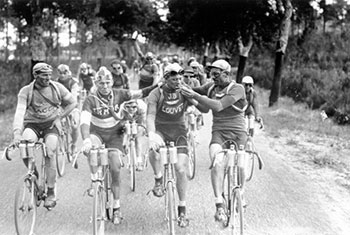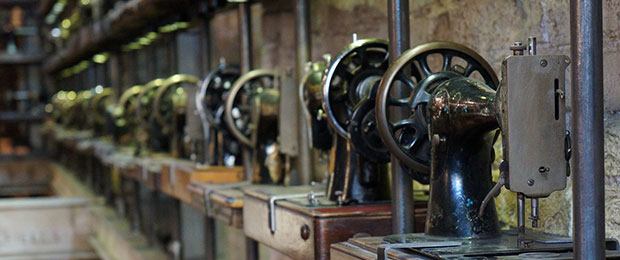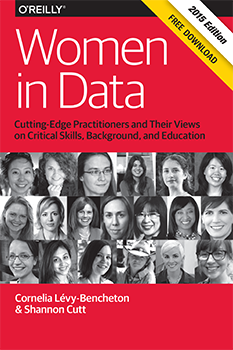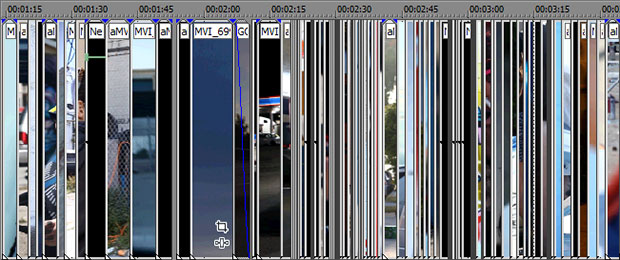"Big Data Culture" entries

Big data is changing the face of fashion
How the fashion industry is embracing algorithms, natural language processing, and visual search.
Download Fashioning Data: A 2015 Update, our updated free report exploring data innovations from the fashion industry.
Fashion is an industry that struggles for respect — despite its enormous size globally, it is often viewed as frivolous or unnecessary.
And it’s true — fashion can be spectacularly silly and wildly extraneous. But somewhere between the glitzy, million-dollar runway shows and the ever-shifting hemlines, a very big business can be found. One industry profile of the global textiles, apparel, and luxury goods market reported that fashion had total revenues of $3.05 trillion in 2011, and is projected to create $3.75 trillion in revenues in 2016.
Solutions for a unique business problem
The majority of clothing purchases are made not out of necessity, but out of a desire for self-expression and identity — two remarkably difficult things to quantify and define. Yet, established brands and startups throughout the industry are finding clever ways to use big data to turn fashion into “bits and bytes,” as much as threads and buttons.
In the newly updated O’Reilly report Fashioning Data: A 2015 Update, Data Innovations from the Fashion Industry, we explore applications of big data that carry lessons for industries of all types. Topics range from predictive algorithms to visual search — capturing structured data from photographs — to natural language processing, with specific examples from complex lifecycles and new startups; this report reveals how different companies are merging human input with machine learning. Read more…

Pattern recognition and sports data
The O'Reilly Data Show Podcast: Award-winning journalist David Epstein on the (data) science of sports.
Sign-up now to receive a free download of the new O’Reilly report “Data Analytics in Sports: How Playing with Data Transforms the Game” when it publishes this fall.

Julien Vervaecke and Maurice Geldhof smoking a cigarette at the 1927 Tour de France. Public domain photo via Wikimedia Commons.
In a recent episode of the O’Reilly Data Show Podcast, I spoke with Epstein about his book, data science and sports, and his recent series of articles detailing suspicious practices at one of the world’s premier track and field training programs (the Oregon Project).
Nature/nurture and hardware/software
Epstein’s book contains examples of sports where athletes with certain physical attributes start off with an advantage. In relation to that, we discussed feature selection and feature engineering — the relative importance of factors like training methods, technique, genes, equipment, and diet — topics which Epstein has written about and studied extensively:
One of the most important findings in sports genetics is that your ability to improve with respect to a certain training program is mediated by your genes, so it’s really important to find the kind of training program that’s best tailored to your physiology. … The skills it takes for team sports, these perceptual skills, nobody is born with those. Those are completely software, to use the computer analogy. But it turns out that once the software is downloaded, it’s like a computer. While your hardware doesn’t do anything alone without software, once you’ve got the software, the hardware actually makes a lot of a difference in how good of an operating machine you have. It can be obscured when people don’t study it correctly, which is why I took on some of the 10,000 hours stuff. Read more…

Cultivating a psychological sense of community
A profile of Dr. Renetta Garrison Tull, from our latest report on women in the field of data.
Download our updated report, “Women in Data: Cutting-Edge Practitioners and Their Views on Critical Skills, Background, and Education,” by Cornelia Lévy-Bencheton and Shannon Cutt, featuring four new profiles of women across the European Union. Editor’s note: this is an excerpt from the free report.
Dr. Renetta Garrison Tull is a recognized expert in women and minorities in education, and in the STEM gender gap — both within and outside the academic environment. Dr. Tull is also an electrical engineer by training and is passionate about bringing more women into the field.From her vantage point at the University of Maryland Baltimore County (UMBC) as associate vice provost for graduate student development and postdoctoral affairs, Dr. Tull concentrates on opportunities for graduate and postdoctoral professional development. As director of PROMISE: Maryland’s Alliance for Graduate Education and the Professoriate (AGEP) program for the University System of Maryland (USM), Dr. Tull also has a unique perspective on the STEM subjects that students cover prior to attending the university, within academia and as preparation for the workforce beyond graduation.
Dr. Tull has been writing code since the seventh grade. Fascinated by the Internet, she “learned HTML before there were WYSIWYGs,” and remains heavily involved with the online world. “I’ve been politely chided in meetings for pulling out my phones (yes plural), sending texts, and updating our organization’s professional Twitter and Facebook status, while taking care of emails from multiple accounts. I manage several blogs, each for different audiences … friends, colleagues, and students.” Read more…

Connected play
How data-driven tech toys are — and aren’t — changing the nature of play.
Sign up to be notified when the new free report Data, Technology & The Future of Play becomes available. This post is part of a series investigating the future of play that will culminate in a full report.
When I was in first grade, I cut the fur pom-poms off of my dad’s mukluks. (If you didn’t grow up in the Canadian North and you don’t know what mukluks are, here’s a picture.) My dad’s mukluks were specially made for him, so he was pretty sore. I cut the pom-poms off because I had just seen The Trouble With Tribbles at a friend’s house, and I desperately wanted some Tribbles. I kept them in a shoebox, named them, brought them to show-and-tell, and pretended they were real.
It’s exactly this kind of imaginative play that a lot of parents are afraid is being lost as toys become smarter. And in exchange for what? There isn’t any real evidence yet that smart toys genuinely make kids smarter.

Low-fi toys. Public domain image, “Boys playing with hoops on Chesnut Street, Toronto, Canada.” Source: Wikimedia Commons.
I tell this story not to emphasize what a terrible vandal I was as a child, rather, I tell it to show how irrepressible childrens’ imaginations are, and to explain why technological toys are not going to kill that imagination. Today’s “smart” toys are no different than dolls and blocks, or in my case, a pair of mukluks. By nature, all toys have affordances that imply how they should be used. The more complex the toy, the more focused the affordances are. Consider a stick: it can be a weapon, a mode of transport, or a magic wand. But an app that is designed to do a thing guides users toward that use case, just as a door handle suggests that you should grasp and turn it. Design has opinions. Read more…

Embracing failure and learning from the Imposter Syndrome
What you miss with a "get it right the first time" mentality
Download our updated Women in Data report, which features four new profiles of women across the European Union. You can also pick-up a copy at Strata + Hadoop World London, where Alice Zheng will lead a session on Deploying Machine Learning in Production.
Lately, there has been a slew of media coverage about the Imposter Syndrome. Many columnists, bloggers, and public speakers have spoken or written about their own struggles with the Imposter Syndrome. And original psychological research on the Imposter Syndrome has found that out of every five successful people, two consider themselves a fraud.
I’m certainly no stranger to the sinking feeling of being out of place. During college and graduate school, it often seemed like everyone else around me was sailing through to the finish line, while I alone lumbered with the weight of programming projects and mathematical proofs. This led to an ongoing self-debate about my choice of a major and profession. One day, I noticed myself reading the same sentence over and over again in a textbook; my eyes were looking at the text, but my mind was saying, “Why aren’t you getting this yet? It’s so simple. Everybody else gets it. What’s wrong with you?”
When I look back upon those years, I have two thoughts: 1. That was hard. 2. What a waste of perfectly good brain cells! I could have done so many cool things if I had not spent all that time doubting myself.
But one can’t simply snap out of the Imposter Syndrome. It has a variety of causes, and it’s sticky. I was brought up with the idea of holding myself to a high standard, to measure my own progress against others’ achievements. Falling short of expectations is supposed to be a great motivator for action…or is it? Read more…

Big data’s impact on global agriculture
The O'Reilly Radar Podcast: Stewart Collis talks about making precision farming accessible and affordable for all farmers.
Stewart Collis, CTO and co-founder of AWhere, recently tweeted a link to a video by the University of Minnesota’s Institute on the Environment, Big Question: Feast or Famine? The video highlights the increasing complexity of feeding our rapidly growing population, and Collis noted its relation to his work at AWhere. I recently caught up with Collis to talk about our current global agriculture situation, the impact of big data on agriculture, and the work his company is doing to help address global agriculture problems.
The challenge, explained Collis, is two-fold: our growing population — expected to increase by another 2.4 billion people by 2050, and the increasing weather variability affecting our growing seasons and farmers’ abilities to produce and scale to accommodate that population. “In the face of weather variability, climate change, and increasing temperatures … farmers no longer know when it’s going to rain,” he said, and then noted: “There’s only 34 growing seasons between now and [2050], so this is a problem we need to solve now.”

Turning Ph.D.s into industrial data scientists and data engineers
The O'Reilly Data Show Podcast: Angie Ma on building a finishing school for science and engineering doctorates.
Editor’s note: The ASI will offer a two-day intensive course, Practical Machine Learning, at Strata + Hadoop World in London in May.
Back when I was considering leaving academia, the popular exit route was financial engineering. Many science and engineering Ph.D.s ended up in big Wall Street banks; I chose to be the lead quant at a small hedge fund — it was a natural choice for many of us. Financial engineering was topically close to my academic interests, and working with traders meant access to resources and interesting problems.
Today, there are many more options for people with science and engineering doctorates. A few organizations take science and engineering Ph.D.s, and over the course of 8-12 weeks, prepare them to join the ranks of industrial data scientists and data engineers.
I recently sat down with Angie Ma, co-founder and president of ASI, a London startup that runs a carefully structured “finishing school” for science and engineering doctorates. We talked about how Angie and her co-founders (all ex-physicists) arrived at the concept of the ASI, the structure of their training programs, and the data and startup scene in the UK. [Full disclosure: I’m an advisor to the ASI.] Read more…

Year Zero: Our life timelines begin
In the next decade, Year Zero will be how big data reaches everyone and will fundamentally change how we live.
Editor’s note: this post originally appeared on the author’s blog, Solve for Interesting. This lightly edited version is reprinted here with permission.
In 10 years, every human connected to the Internet will have a timeline. It will contain everything we’ve done since we started recording, and it will be the primary tool with which we administer our lives. This will fundamentally change how we live, love, work, and play. And we’ll look back at the time before our feed started — before Year Zero — as a huge, unknowable black hole.
This timeline — beginning for newborns at Year Zero — will be so intrinsic to life that it will quickly be taken for granted. Those without a timeline will be at a huge disadvantage. Those with a good one will have the tricks of a modern mentalist: perfect recall, suggestions for how to curry favor, ease maintaining friendships and influencing strangers, unthinkably higher Dunbar numbers — now, every interaction has a history.
This isn’t just about lifelogging health data, like your Fitbit or Jawbone. It isn’t about financial data, like Mint. It isn’t just your social graph or photo feed. It isn’t about commuting data like Waze or Maps. It’s about all of these, together, along with the tools and user interfaces and agents to make sense of it.
Every decade or so, something from military or enterprise technology finds its way, bent and twisted, into the mass market. The client-server computer gave us the PC; wide-area networks gave us the consumer web; pagers and cell phones gave us mobile devices. In the next decade, Year Zero will be how big data reaches everyone. Read more…

An alternate perspective on data-driven decision making
The O'Reilly Radar Podcast: Tricia Wang on "thick data," purpose-driven problem solving, and building the ideal team.
In this week’s Radar Podcast episode, O’Reilly’s Roger Magoulas chatted with Tricia Wang, a global tech ethnographer and co-founder of PL Data, about how qualitative and quantitative data need to work together, reframing “data-driven decision making,” and building the ideal team.
Purpose-driven problem solving
Wang stressed that quantitative and qualitative need to work together. Rather than focusing on data-driven decision making, we need to focus on the best way to identify and solve the problem at hand: the data alone won’t provide the answers:
“It’s been kind of a detriment to our field that there’s this phrase ‘data-driven decision making.’ I think oftentimes people expect that the data’s going to give you answers. Data does not give you answers; it gives you inputs. You still have to figure out how to do the translation work and figure out what the data is trying to explain, right? I think data-driven decision making does not accurately describe what data can do. Really what we should be talking about is purpose-driven problem solving with data. Read more…

How data and connectivity are changing the nature of play
Now that technology has made its way into the playroom, there are a lot of important questions we should be asking.
Sign up to be notified when the new free report Data, Technology & The Future of Play becomes available. This post is part of a series investigating the future of play that will culminate in a full report.
Playing is how we learn. Through play, we develop large and fine motor skills, refine language and social interaction, and discover important facts about everything from the cycle of life and death to the laws of physics. When we play, we test the world around us, and share and grow.
But play is changing because it’s now filled with technology. In the coming months, I’m going to be looking at how data and connectivity are changing toys and the very nature of play. I’ll be talking to designers, inventors, technologists, and educators, and publishing the results in a report for O’Reilly Media.
Here’s my thinking so far:
Until very recent times, play was a purely tangible, real-world experience. Almost every adult alive has built a tower of blocks, climbed something, chased another person, used a skipping rope, and put together a puzzle. We all know the rules of tag and hide and seek. Some of our fondest memories include creative and imaginative play. We were pirates. We were princesses. We were explorers in a new, exciting land, limited only by our own imaginations and the loving cry of parents calling us home for dinner. Read more…






